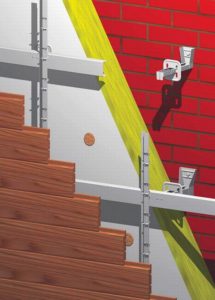Energy efficiency of ventilated façades with synthetic wood cladding.

 There is a direct relationship between energy consumption and CO₂ emissions. The greater the increase in consumption, the greater the increase in emissions, which is why energy efficiency is one of the main instruments for restoring the proportion of greenhouse gases in the environment.
There is a direct relationship between energy consumption and CO₂ emissions. The greater the increase in consumption, the greater the increase in emissions, which is why energy efficiency is one of the main instruments for restoring the proportion of greenhouse gases in the environment. The placement of façade cladding with synthetic wood using rigid extruded polystyrene insulation boards between the existing façade and the new cladding, is ideal for insulation of enclosure walls, its main benefits being perceived in the increase of living comfort and the reduction of the risk of condensation.
The placement of façade cladding with synthetic wood using rigid extruded polystyrene insulation boards between the existing façade and the new cladding, is ideal for insulation of enclosure walls, its main benefits being perceived in the increase of living comfort and the reduction of the risk of condensation.Main advantages of exterior insulation.
Both in new construction and in renovation, the installation of external insulation has great advantages over traditional internal insulation systems (in which the insulation is interrupted at the junction of the slabs).
1. Thermal bridges are minimised and condensation is prevented.
2. The continuity of the thermal insulation avoids temperature differences between the different points of the building's construction elements.
3. Thermal shocks are avoided.
4. The enclosure can make better use of its thermal inertia.
5. The construction process is simpler and faster.
6. There is no decrease in the usable area inside the dwellings.
7. The inhabitants of the dwellings are not disturbed with.
8. At the same time as insulating, decorating and renovating facades.
9. The system increases the economic value of the property.
10. Rapid amortisation. Sources:
AIPEX and Fundación la casa que ahorra.
